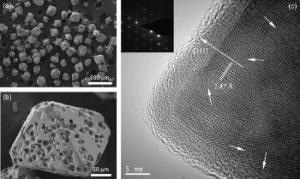Nov 15 2016
 Electron micrographs of tiny superparamagnetic crystals of magnetite at different resolutions. The lowest resolution image (a) shows the octahedral crystals. At higher resolution, the 'craters' on the crystal surfaces are clearly visible. The highest resolution image (c) shows some of the defects in the crystal lattice, highlighted with the white arrows. (Credit - Elsevier B.V)
Electron micrographs of tiny superparamagnetic crystals of magnetite at different resolutions. The lowest resolution image (a) shows the octahedral crystals. At higher resolution, the 'craters' on the crystal surfaces are clearly visible. The highest resolution image (c) shows some of the defects in the crystal lattice, highlighted with the white arrows. (Credit - Elsevier B.V)
Microscopic crystals could soon be transporting drugs within a person’s body, taking them directly to diseased organs. This was thought to be unachievable in the past, as the crystals, which possess special magnetic attributes, were so tiny that scientists were not able to manipulate their movement.
A solution has been discovered by Chinese researchers recently. This discovery has paved the way for new applications that could apply these crystals to optimize – and maybe even save a number of lives.
Kezheng Chen and Ji Ma from Quingdou University of Science and Technology have published a technique of generating superparamagnetic crystals that are a lot bigger than any that have been produced previously. Their research findings are published in Physics Letters A.
If certain magnetic materials, such as iron oxides, are small enough – perhaps a few millionths of a millimeter across, smaller than most viruses – they have a remarkable property: their magnetization randomly flips when there is a change in temperature.
Scientists can engineer them to almost as strongly magnetic as common fridge magnets by applying a magnetic field to these crystals. It might appear unusual, but this is the strongest type of magnetism identified. This phenomenon is referred to as superparamagnetism.
Theoretically, superparamagnetic particles could be suitable for drug delivery, as they can be directed to a tumor just by applying a magnetic field. Their miniature size, however, has made them tough to steer precisely - until recently.
The largest superparamagnetic materials that we have been able to make before now were clusters of nanocrystals that were together about a thousand times smaller than these. These larger crystals are easier to control using external magnetic fields, and they will not aggregate when those fields are removed, which will make them much more useful in practical applications, including drug delivery.
Dr. Kezheng Chen, Quingdou University of Science and Technology
Chen and Ma explained that the high pressure and temperature under which the crystals develop made miniature meteorite-like ‘micro-particles’ of magnetite flee from their surface. This caused the odd pock-marked exterior of the crystal surfaces and brought on a high degree of strain and stress into the lattice of the developing crystals.
Crystals that form under such high strains and stresses develop defects and irregularities in their crystal lattice, and it is these irregularities that cause the extraordinary magnetic properties of Chen’s crystals.
Similar sized magnetite crystals that are formed at a lower temperature and under usual pressure are only very faintly magnetic.
This technique of producing larger superparamagnetic crystals opens a path to the creation of superparamagnetic bulk materials that can be reliably manipulated by mild external magnetic forces, transforming delivery of drugs to tumors and other sites in the body that require to be targeted precisely.
And this is only the start. Chen's crystals may, for instance, be applicable in the several engineering projects that require "smart fluids" that alter their properties when a magnetic field is applied. These can already be used to develop vehicle suspension systems that automatically change as road conditions change, providing more safety and comfort, and to construct realistic and more comfortable prosthetic limbs.
Since superparamagnetism is no longer limited just to minute particles that are tough to handle, scientists can start investigating the ways in which this can contribute to enhancing the lives of people.